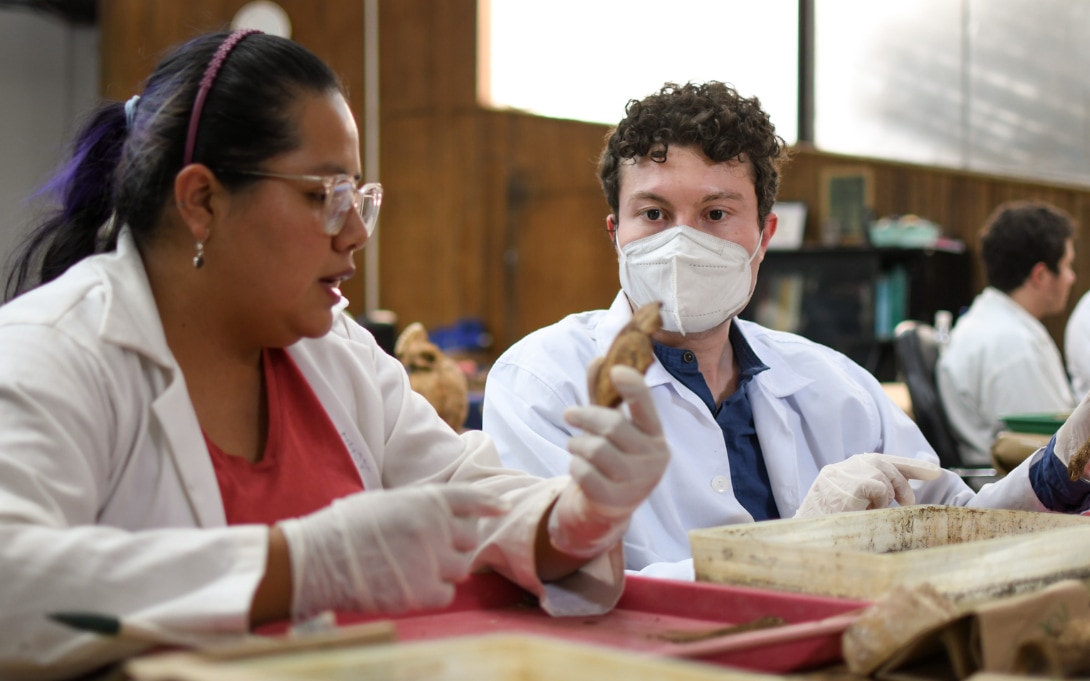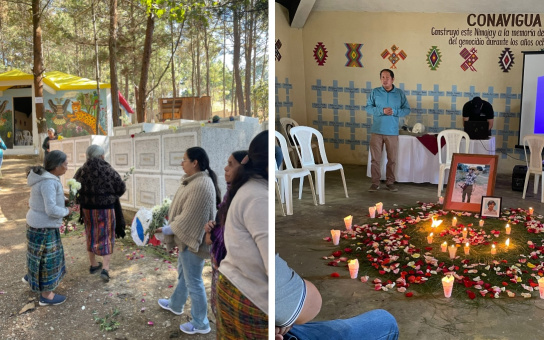
Lessons in restorative justice
By Miriam Wasserman
In spring 2019, Aprisal Malale (MPP '20) found himself at the side of an unmarked grave in Guatemala.
Malale, along with Towsley Policymaker in Residence Hardy Vieux (MPP/JD '97), and three classmates were there to bear witness to the scars of the internal armed conflict in Guatemala and learn from the Forensic Anthropology Foundation of Guatemala (FAFG).
They had been at the foundation's headquarters in Guatemala City when a caller reported an unmarked grave an hour-and-a-half drive away. The students and Vieux went with FAFG experts to the site. In this case, they were met by a family who suspected their loved one was the victim and were present to identify any clothing or items found at the site. Accompanied by a representative of the local government, the FAFG team conducted an exhumation and gathered information that could help identify the victim through DNA sampling at the lab.
There was tremendous sadness at the scene. But also a palpable sense of relief.
FAFG's effort to bring connection back to the family is what stays most with Malale. It enabled the relatives, "to understand that this is probably their father who has been missing for 20-30 years and that they can make peace knowing that he has passed away, and they can bury him properly," says Malale.
"Restorative justice is a balancing act between holding people to account and the realities of the society's need to move on. It has this 'repairing the harm that was done' piece to it. That's FAFG's focus," says Vieux who, with the sponsorship of the International Policy Center, has led and helped organize three trips to volunteer with FAFG in Guatemala, including one in March 2023.
"We knew we were going to be taking in a lot. We have no idea what these people have gone through," says Maggie Barnard (MPP '21) who visited FAFG in the second of the three delegations. To prepare, Barnard and her fellow student volunteers participated in trauma-informed care training before going.
The conflict in Guatemala, which lasted between 1960 and the signing of the Peace Accords in 1996, was one of the most brutal in contemporary Latin America. It left 200,000 victims, the vast majority Mayan, including 40,000 people who were forcibly disappeared, according to the United Nations-backed Commission for Historical Clarification.
FAFG started in the early 1990s as a small team to search and identify victims of the conflict under the guidance of renowned forensic anthropologist Dr. Clyde Snow. It became a formal foundation in 1997. Today, the non-governmental organization employs 110 people. Its headquarters include an osteology lab—where remains are cleaned and analyzed to determine age, gender, and possible cause of death—and a DNA lab, where samples of genetic material from the bodies and relatives of the disappeared are extracted, analyzed, and matched. FAFG is also sharing expertise internationally, assisting organizations confronting matters of disappeared persons in Mexico and Colombia.
Vieux, whose international human rights course touches on issues of restorative justice, met FAFG Executive Director Fredy Peccerelli at a human rights panel in New York City and thought the trips would provide a unique opportunity for Ford School students. In addition to his role at the Ford School, Vieux is currently the chief of staff at Kids in Need of Defense (KIND) in Washington, DC.

Students are not passive observers. At FAFG's lab, they help clean and sort the remains. They also respond to requests from FAFG for assistance in areas where they have some expertise. Barnard's team, for instance, put together recommendations for combining quantitative and qualitative measures of FAFG's impact to help the organization with fundraising.
But they mostly come to learn. And there are no clear-cut answers about the right balance between healing, accountability, justice, and closure.
Some of the forensic evidence gathered by FAFG has been used in trials of former military officers. Guatemala became the first country to prosecute a former head of state in a national court for genocide. But the 2013 guilty verdict against retired Army general Efraín Ríos Montt was dismissed days later on technical terms. His daughter, Zury Rios Montt, is currently a leading candidate in the Guatemalan presidential elections of 2023.
"FAFG is realistic. They are not sitting around thinking that perpetrators of forced disappearances will regularly be held to account. But there is still a lot of good that can be done," says Vieux.
There has been such a big push to deny what happened. It is important to elevate and clarify history through different aspects, whether it be through forensics, through testimony, through archives, or education."
Erica Henderson
"It is about breaking down this idea of justice and understanding that justice may not only be happening in a courtroom. Justice can also be knowing that somebody is actively looking for your disappeared loved one and feeling involved and invited into that process," says Erica Henderson, special assistant to Peccerelli at FAFG.
At the exhumation site, FAFG staff spent quite a bit of time explaining to the family members why they were there, what was about to happen, and getting their approval. The family chose to do a traditional ceremony first. "There were a series of things that needed to be done. Not to check boxes, but to let the family understand that we were working for them," says Vieux.
The effort to connect families to their missing loved ones is ongoing. Many exhumations are anonymous. FAFG encourages families with missing relatives to provide DNA samples to help identify victims. In their 25 years of work, FAFG has identified over 3,800 victims and recovered over 8,000 bodies.
"There has been such a big push to deny what happened. It is important to elevate and clarify history through different aspects, whether it be through forensics, through testimony, through archives, or education," Henderson notes. While victim recovery and identification remains the cornerstone of FAFG's work, they are also recording interviews of survivors with the USC Shoah Foundation and working on memorialization.
"They risk their lives every day because they are doing this contrarian work. But by telling the truth and setting up these memorials, they are slowly but surely impacting the narrative," says Barnard.
A memorial in San Juan Comalapa stands as concrete testimony of the process taking place in Guatemala. The location, from which 220 bodies were recovered, was a sacred Kaqchikel site that became a military detention center during the conflict. In 2018, the widows association of CONAVIGUA asked FAFG to return the unidentified remains of 172 victims to the site, so that nearby families and CONAVIGUA could become their caretakers. The memorial includes a mausoleum, murals by local artists, and the names of over 6,000 people who remain missing.
It is now a space for victims' families to lay a flower and spend time honoring their loved ones as well as for school groups to come and learn. "A very place of terror is now a place of memory," says Henderson.
More in State & Hill
Below, find the full, formatted spring 2023 edition of State & Hill. Click here to return to the spring 2023 S&H homepage.
